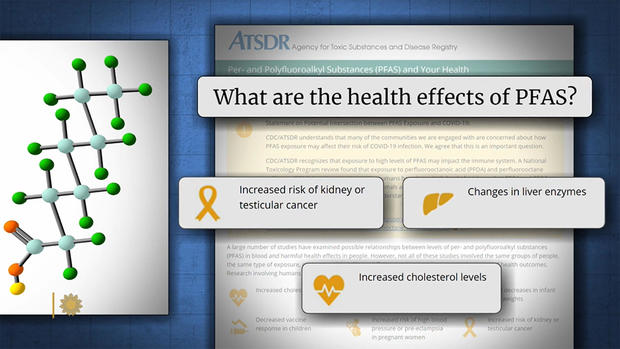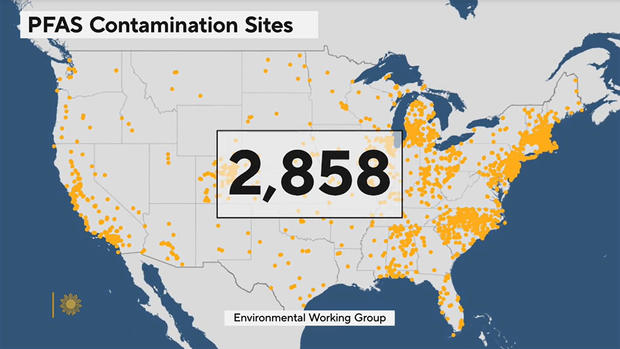Eternal Chemicals: The Threat of PFAS in Water
On a cold winter's day at Stoneridge Dairy in Arundel, Maine, Fred Stone worried that his cows were colder than he was, especially a precious Brown Swiss cow named Blue. "She likes to torment me whenever she can," Stone told correspondent Lee Cowan.
Fred and his wife Laura are the last generation to work on this dairy. It has been in the family for over a century.
But every drop of milk that has been a reliable livelihood for generations since November 2016 is now pouring down the drain.
"What a waste," said Stone. "Even I can't drink it."
He said the wastewater the state allows to be used to fertilize his fields also contains potentially toxic chemicals called PFAS. I didn't know you were there. Now his land, his cows (and yes, their milk) are all contaminated.
Cowan asked, "Have you heard of PFAS and these chemicals?"
"Never," he replied.
Most people don't. PFAS is an acronym for a family of man-made compounds called perfluoroalkyl and polyfluoroalkyl substances. The CDC lists many health effects believed to be associated with exposure to these chemicals, including cancer, liver damage, and increased cholesterol. Chemicals are highly mobile and are present in the air as well as soil and groundwater. In fact, it has even been detected in raindrops falling in the most remote regions of the world.

PFAS chemicals decades ago exists from DuPont was the first company to use his PFAS in Teflon, giving us nonstick pots and pans. 3M used another of his PFASs in their once-popular fabric protector, Scotchgard.
Even today, these chemical cousins are found in nearly everything designed to keep oil, water, and grease at bay. This includes pizza boxes, paper plates, rain jackets, ski wax, guitar strings, and more.
PFAS are basically impossible to escape, and scientists say they are likely to stay here.
``They are almost immortal...you can't get rid of them. It decomposes slowly. PFAS don't. If you put PFAS somewhere, it will effectively stay there forever."
So these so-called "eternal chemicals" levels accumulates and can remain in our bloodstream forever.
Kathy and Bruce Harrington were notified by the Maine Department of Environmental Protection that her drinking water was contaminated with PFAS. "Ours is 26,000 per trillion."
For Mr. and Mrs. Harrington, who live next door to their farm and use a well, the source is not far away. He could be two factories. I have.
"They came and 'tested our water,'" said Cathy. I got a call a few days later and she was told 'Don't drink the water, don't use it for cooking, it's nothing'.
What is it all for, Bruce asked. I don't need eggs spilling out of a frying pan compared to people dying.
Melanie Benes, a legislative attorney with the Environmental Working Group in Washington, said, "PFAS contamination is truly a national crisis. The sheer scale of the contamination is staggering.

He said thousands of facilities were contaminated with PFAS. And she blames the growing crisis squarely on the feet of the companies that invented the chemicals in the first place. "It's manufacturers like DuPont and 3M." So they've known for 70 years that they're putting poison in the water. Their workers. A lawsuit was filed against the manufacturer.
But Benes said manufacturers were not the only ones to blame, saying, "There have also been regulatory failures. We've known this for ages, but we haven't treated this issue with the urgency needed."
Regulating PFAS is like playing whack-a-mole. DuPont and 3M have phased out two of her PFASs, which he suspects are the most harmful, but still manufacture other her PFASs. In fact, there are thousands of variants.
Benes said, "Many of them are actually similar, so it is very likely that one is just as toxic as the other.
almost a decade ago, Detlef Knappe, an environmental engineering professor at North Carolina State University, began water testing near the plant on the Cape River, Fear River.2017,His research made headlines.: According to a new study called PFAS, GenX was clearly present in water
in a mother of two children who lived approximately 80 miles downstream from the Chemours plant. One Emily Donovan said, "That's unholy. We live in America. We should be able to enjoy the shower. Give me and my children cancer."
The Cape Fear River provides drinking water for more than 350,000 people in and around Wilmington, North Carolina. Like most people, Donovan always thought he was safe. "Because the EPA does not require utilities to routinely test, the average American currently has a
Based on what it calls new evidence, this June the EPA updated its drinking water advisory on PFAS,indicating that negligible He warned that even moderate amounts could be enough to adversely affect health. However, it fell short of creating a new federal drinking water standard.
"There have been no new drinking water standards in the United States since the 1990s," she said, Donovan. So she co-founded a community action group called Clean Cape Fear, . The group, among other things, has fought for both federal and state agencies to crack down more heavily on all of her PFAS contaminants.
"You have two options for her: Either break it down or turn that energy and heartbreak into something positive towards something productive," Donovan said. Told.
Chemours was forced to implement many anti-pollution technologies by state environmental regulators. It cost them millions.
In a statement to CBS News, the company has destroyed "more than 99.99% of his PFAS" in the air and said that "her PFAS compounds reaching the Cape Fear River...97 percent,” he said.
For her PFAS, which have accumulated in the ground over the years, Chemmers said she would build a barrier to capture and treat groundwater.
Detlef Knappe said, "The exposure of people living downstream has decreased dramatically. It is much more severe for those living in close proximity to factories whose wells have been contaminated."
Professor Knappe's current research interest is to determine the amount, if any, of PFAS in foods grown nearby. "Analysis of some of the backyard produce in the area suggests that levels may be significantly higher," he said.
Residents like Jane Jacobs - members of the Native Tuscarora Nation - have always viewed the land as sacred. "I'm afraid it's too late," she told Cowan. She "fears that she will die from what she has ingested."
there is
"My people have always hunted in this swamp, but they feed on the river," she said. "So animals are polluted in the same way that water is polluted.Because they drank water from rivers and swamps.
Those who live outside the land are not willing to poison it. Fred Stone is certainly one of those people, and so are farmers in nearly every state who use treated wastewater to nourish their fields. He, like his father and his grandfather, regarded their soil as part of their soul. Cold and drafts, rather than man-made chemicals, were considered the greatest threats.
Stone said, "At some point I will have to tell my father and grandfather what I did on the farm they entrusted me with." Cowan said, "But this is not your fault."
"It wasn't my fault, but it was under my watch. And now it's gone. That's it." That's it."
For more information:
- Defend Our Health, Portland, Me.
- Environmental Working Group, Washington D. C.
- Clean Cape FearWilmington, NC
- Detlef Knappe, NC State University
- Stoneridge Farm, Arundel, ME. (Facebook)
- Tuscarora Nation, North Carolina
- Chemours
Story produced by Sari Aviv. Editor: George Pozderek.
Thank you for visiting CBS NEWS.
Create a free account or log in to
for more features.


